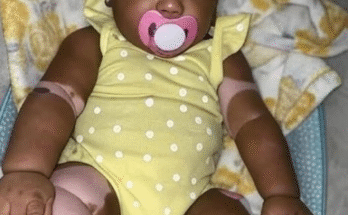Tragic Case Highlights the Hidden Dangers of Neglected Childhood Infestations
Childhood is often viewed as a period of innocence, growth, and protection. Parents, caregivers, and educators are generally vigilant about the physical and emotional safety of children. Yet, beneath the surface of ordinary domestic life, hidden dangers can lurk in seemingly minor health concerns. A recent tragic case involving a neglected childhood infestation has drawn attention to this often-overlooked issue, exposing the severe consequences that can arise when infestations—such as lice, scabies, or parasitic infections—are ignored or inadequately treated. The case underscores the importance of awareness, timely intervention, and systemic support in safeguarding children’s health.
The Incident
The case in question involves a young child who, over several months, suffered from a persistent infestation that was largely dismissed by caregivers as a minor nuisance. Reports indicate that the infestation caused intense itching, skin irritation, and discomfort, but more critically, it led to severe secondary infections due to constant scratching. As time passed, the child’s condition worsened, culminating in a medical emergency that required hospitalization. Despite treatment, the damage to the child’s health was profound, highlighting the potentially catastrophic consequences of neglecting infestations in early life.
Health professionals involved in the case have emphasized that infestations, while often considered harmless annoyances, can serve as gateways for more serious complications. Secondary bacterial infections, allergic reactions, anemia, and sleep disturbances are common among children with untreated infestations. In extreme situations, particularly when compounded by systemic neglect or lack of medical care, infestations can contribute to long-term health problems or even fatal outcomes.
Understanding Childhood Infestations
Childhood infestations come in many forms, ranging from external parasites like lice and scabies to internal parasites such as pinworms or intestinal worms. Each type carries unique risks and requires specific intervention strategies.
-
Head Lice: While not typically dangerous, untreated lice infestations can lead to intense itching, sleep disruption, and secondary bacterial infections caused by scratching. Lice spread quickly among school-aged children, and outbreaks often occur in group settings.
-
Scabies: Caused by mites burrowing into the skin, scabies can lead to severe itching, rash, and lesions that become infected if left untreated. Transmission occurs through close physical contact, making children particularly vulnerable in households and schools.
-
Parasitic Infections: Internal parasites, such as pinworms, roundworms, and hookworms, can cause gastrointestinal distress, malnutrition, anemia, and impaired growth. Symptoms may be subtle initially, which can delay diagnosis and treatment.
Despite the prevalence of these conditions, many caregivers underestimate their seriousness, viewing them as temporary discomforts rather than potential health hazards. The tragic case in question illustrates how this perception can have devastating consequences.
Psychological and Social Impacts
Beyond physical health, neglected infestations can profoundly affect a child’s psychological and social well-being. Children with visible infestations often experience embarrassment, stigma, and bullying, particularly in school settings. Persistent discomfort and sleep deprivation can impair concentration, learning, and emotional regulation, affecting academic performance and social interactions.
Moreover, children who endure chronic infestations without support may develop anxiety, low self-esteem, and a sense of helplessness. In severe cases, the psychological toll can rival the physical damage, leaving long-lasting effects that persist even after the infestation is eradicated.
Systemic Failures and Risk Factors
Neglected infestations often result from systemic failures, including gaps in parental awareness, insufficient access to healthcare, and socio-economic barriers. Families struggling with financial hardship may delay seeking treatment due to cost concerns, limited access to medical professionals, or lack of information about effective interventions.
In other instances, caregivers may underestimate the severity of symptoms or attribute them to minor skin irritations or temporary discomforts. Schools and childcare providers, while frequently vigilant about outbreaks, may not always have the resources or training to identify and respond effectively to infestations.
Additionally, cultural misconceptions can influence treatment-seeking behavior. Some families may rely on home remedies or traditional practices that are ineffective, delaying proper medical intervention. The cumulative effect of these factors can turn a manageable infestation into a severe medical crisis.
Medical Complications
The medical risks associated with neglected infestations are often underestimated. Continuous scratching from external parasites can break the skin, creating entry points for bacterial infections such as impetigo. Scabies and lice, while primarily causing discomfort, can exacerbate secondary infections that require antibiotic treatment.
Internal parasites can compromise nutrition, leading to anemia, weight loss, and delayed growth. Severe infestations may even affect organ function if left untreated for extended periods. For children with pre-existing health conditions, the impact can be particularly dangerous, making early detection and intervention essential.
In the tragic case at hand, the combination of prolonged discomfort, untreated secondary infections, and delayed medical care created a cascade of health complications. Medical professionals emphasized that timely intervention could have prevented much of the damage, highlighting the critical importance of education, vigilance, and proactive healthcare access.
Preventative Measures and Education
Preventing infestations and mitigating their impact requires a multifaceted approach:
-
Parental Awareness: Caregivers must be educated on recognizing early signs of infestations, understanding potential risks, and seeking prompt treatment. This includes knowing how to identify lice, scabies, or intestinal parasites and understanding recommended medical interventions.
-
School and Community Programs: Educational campaigns in schools and community centers can raise awareness about the spread of infestations and encourage proactive measures. Routine screenings, hygiene education, and prompt reporting can prevent outbreaks from escalating.
-
Access to Healthcare: Affordable and accessible healthcare services are essential for diagnosing and treating infestations before they become severe. Pediatricians, dermatologists, and public health clinics play a crucial role in providing guidance and interventions.
-
Cultural Sensitivity: Understanding cultural beliefs and practices around health is important for ensuring compliance with medical advice. Tailoring education and treatment programs to diverse communities can improve outcomes.
Lessons Learned from the Tragedy
The tragic case serves as a powerful reminder of the hidden dangers associated with neglected childhood infestations. It underscores several key lessons:
-
Early Detection Saves Lives: Even seemingly minor symptoms should be taken seriously, as early intervention can prevent escalation.
-
Education Matters: Awareness campaigns for parents, caregivers, and children are crucial for reducing risk and stigma.
-
Systemic Support is Essential: Affordable, accessible healthcare and school-based prevention programs can significantly mitigate the dangers of infestations.
-
Holistic Approach: Treating infestations involves addressing physical symptoms, emotional well-being, and social factors to ensure comprehensive care.
These lessons extend beyond individual cases, emphasizing the broader societal responsibility to protect children from preventable health risks.
Moving Forward
In the aftermath of the tragedy, healthcare professionals and child advocates are calling for increased education, better access to treatment, and more proactive monitoring of childhood health in schools and communities. Public health campaigns can play a critical role in reducing stigma, dispelling myths, and empowering caregivers to take timely action.
Furthermore, the case has sparked discussions about the importance of viewing children’s health holistically. Infestations are not merely inconveniences—they are potential catalysts for severe physical, psychological, and social harm. By recognizing their seriousness, society can take concrete steps to prevent similar tragedies in the future.
Conclusion
The tragic story of a neglected childhood infestation serves as a sobering reminder that even seemingly minor health issues can escalate into life-threatening situations if ignored. Beyond the physical discomfort, infestations carry psychological, social, and medical risks that require attention, awareness, and proactive intervention.
This case highlights the importance of parental vigilance, education, and systemic support in safeguarding children’s health. It also underscores the need for society to recognize that preventable health crises often arise from neglect—whether due to lack of resources, awareness, or support.
By learning from such tragedies, communities can implement measures to identify and treat infestations early, protect vulnerable children, and reduce the hidden dangers that too often go unnoticed. Ultimately, the case reminds us that childhood health is a shared responsibility, and that vigilance, education, and timely care can prevent unnecessary suffering and save lives.



